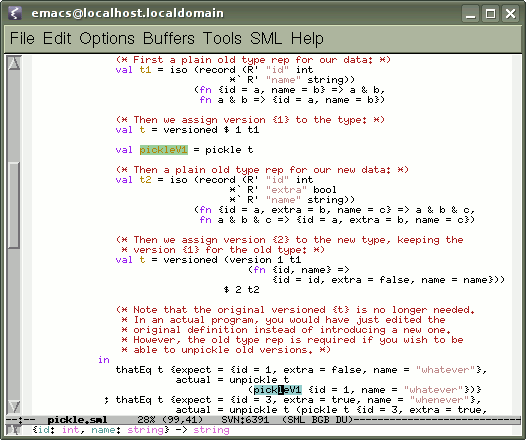MLton provides an option,
-show-def-use file, to output precise (giving exact source
locations) and accurate (including all uses and no false data)
whole-program def-use information to a file. Unlike typical tags
facilities, the information includes local variables and distinguishes
between different definitions even when they have the same name. The
def-use Emacs mode uses the information to provide navigation support,
which can be particularly useful while reading SML programs compiled
with MLton (such as the MLton compiler itself).
Screen Capture
Note the highlighting and the type displayed in the minibuffer.

Features
-
Highlights definitions and uses. Different colors for definitions, unused definitions, and uses.
-
Shows types (with highlighting) of variable definitions in the minibuffer.
-
Navigation:
jump-to-def,jump-to-next, andjump-to-prev. These work precisely (no searching involved). -
Can list, visit and mark all references to a definition (within a program).
-
Automatically reloads updated def-use files.
-
Automatically loads previously used def-use files at startup.
Download
Setup
The easiest way to load def-use mode is to first tell Emacs where to find the files. For example, add
(add-to-list 'load-path (file-truename "path-to-the-el-files"))to your ~/.emacs or ~/.xemacs/init.el. You’ll probably
also want to start def-use-mode automatically by adding
(require 'esml-du-mlton)
(def-use-mode)to your Emacs init file. Once the def-use mode is activated, you
should see the DU indicator on the mode line.
Usage
To use def-use mode one typically first sets up the program’s makefile
or build script so that the def-use information is saved each time the
program is compiled. In addition to the -show-def-use file
option, the -prefer-abs-paths true expert option is required.
Note that the time it takes to save the information is small (compared
to type-checking), so it is recommended to simply add the options to
the MLton invocation that compiles the program. However, it is only
necessary to type check the program (or library), so one can specify
the -stop tc option. For example, suppose you have a program
defined by an MLB file named my-prg.mlb, you can save the def-use
information to the file my-prg.du by invoking MLton as:
mlton -prefer-abs-paths true -show-def-use my-prg.du -stop tc my-prg.mlb
Finally, one needs to tell the mode where to find the def-use
information. This is done with the esml-du-mlton command. For
example, to load the my-prg.du file, one would type:
M-x esml-du-mlton my-prg.du
After doing all of the above, find an SML file covered by the previously saved and loaded def-use information, and place the cursor at some variable (definition or use, it doesn’t matter). You should see the variable being highlighted. (Note that specifications in signatures do not define variables.)
You might also want to setup and use the Bg-Build mode to start builds automatically.
Types
-show-def-use output was extended to include types of variable
definitions in revision r6333. To get good type names, the
types must be in scope at the end of the program. If you are using the
ML Basis system, this means that the root MLB-file for your
application should not wrap the libraries used in the application inside
local … in … end, because that would remove them from the scope before
the end of the program.